RBT Documentation – Domain E | Free ABA Reporting Guide
This module introduces the responsibilities of RBT documentation under the Domain E framework of the RBT Task List. In Applied Behavior Analysis (ABA), accurate documentation and timely reporting are not just administrative tasks — they are critical components of ethical, effective, and legally compliant service delivery. For Registered Behavior Technicians (RBTs), Domain E of the RBT Task List outlines the skills required to support supervisors through clear communication, responsible reporting, and objective recordkeeping. In Domain E of the RBT Task List, tasks E-1 to E-5 outline the standards for communication, documentation, and ethical recordkeeping in ABA.
These tasks ensure the flow of essential information across the treatment team, help maintain continuity of care, and support compliance with funding sources, licensure bodies, and organizational protocols. When implemented correctly, documentation and reporting directly impact the client’s progress, the team’s decision-making, and the legal protection of all involved.
Domain E consists of five task items (E-1 to E-5), which together form the foundation of professional communication in ABA practice. From session notes to incident reporting, these skills reinforce trust, transparency, and accountability in every session.
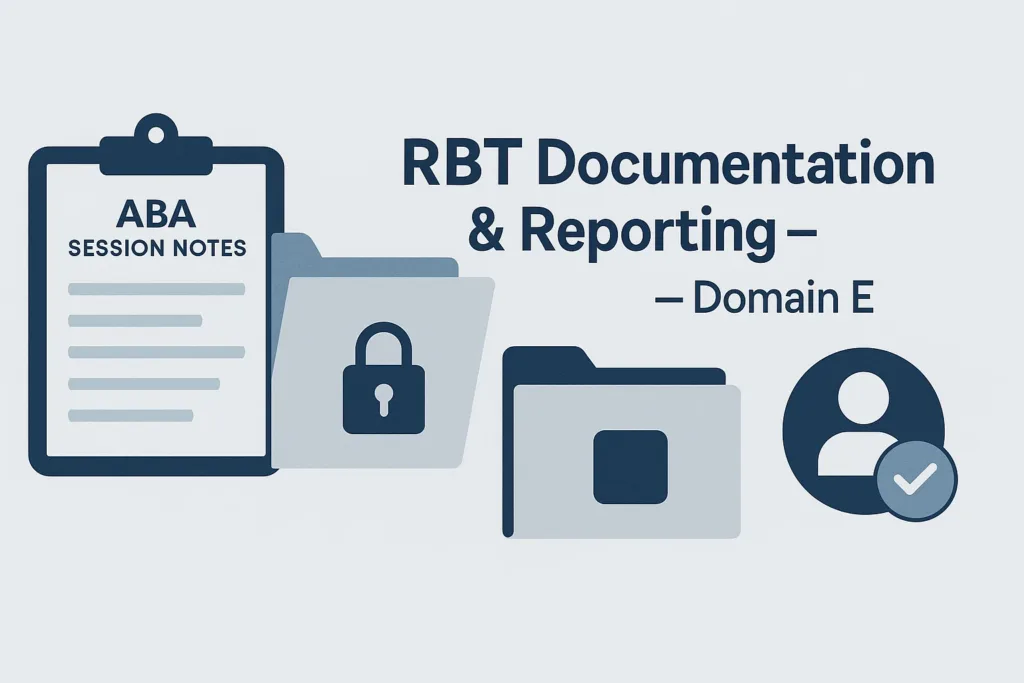
Table of Contents
E-1: Effectively Communicate with a Supervisor in an Ongoing Manner
Consistent and open communication with a supervising behavior analyst is a professional requirement for RBTs. As part of the ABA service delivery model, RBTs are expected to share session updates, progress data, challenges, and observations regularly with their supervisors — both formally and informally. Timely and accurate RBT session notes are essential for maintaining clinical integrity and keeping the treatment team aligned.
Examples of effective communication:
- Sharing that a client’s tantrums have increased over the past three sessions despite consistent implementation of the Behavior Intervention Plan (BIP)
- Notifying the supervisor that a new behavior (e.g., elopement) has appeared during transition times
- Asking for clarification on whether to continue prompting a skill that has reached 90% mastery
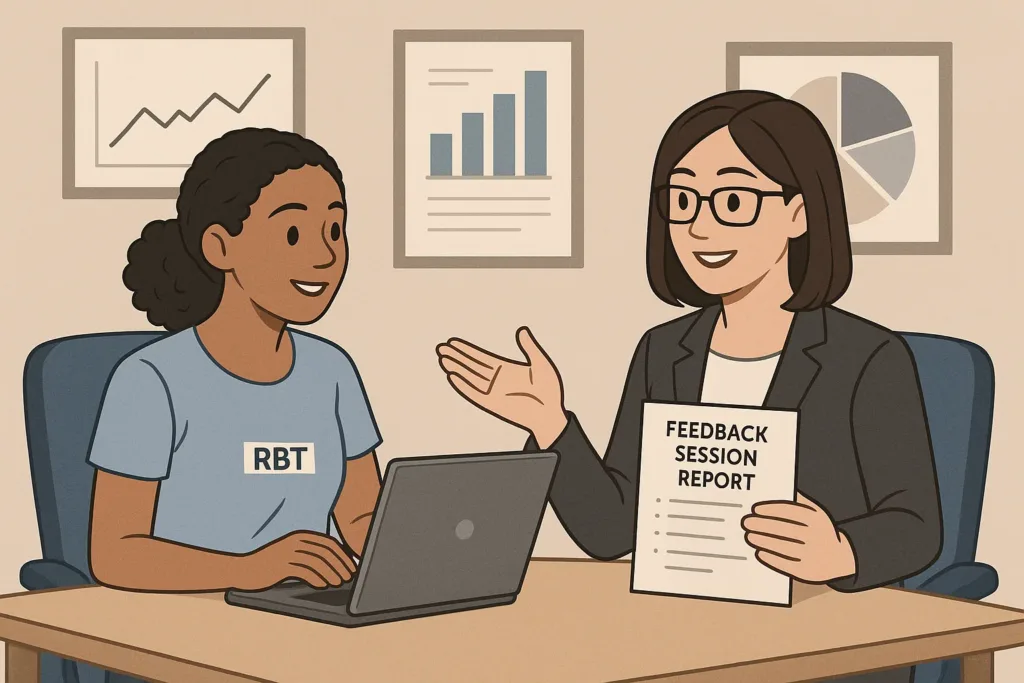
Communication can occur through written updates, verbal conversations, emails, or digital note-sharing systems, depending on the organization’s structure. Regardless of the format, the information must be clear, objective, and timely.
Common mistakes to avoid:
- Waiting too long to report an issue (e.g., waiting a week to mention increased aggression)
- Withholding feedback out of fear of “bothering” the supervisor
- Reporting vague information (e.g., “the session didn’t go well”) without context or data
Tips for RBTs:
- Keep a running list of notes or questions to bring up in supervision
- Use data to guide your communication
- Document conversations for clarity and accountability
Maintaining open dialogue supports client safety, professional development, and clinical integrity — and it’s essential to staying within the scope of the RBT Task List.
E-2: Actively Seek Clinical Direction from Supervisor in a Timely Manner
While RBTs are trained to implement intervention plans, they are not responsible for making clinical decisions. That’s why seeking guidance from a supervising BCBA is not just encouraged — it’s required when uncertainty or unexpected scenarios arise. When seeking clinical direction, always refer to objective ABA data collection to support your observations and requests.
Situations that require immediate direction:
- A client begins displaying new, dangerous behavior not listed in the BIP
- A skill plateau occurs and the RBT is unsure whether to continue or pause teaching
- The client’s family shares concerns that may impact service delivery (e.g., a new medication, family stressors)
In each case, the RBT should contact their supervisor immediately and document the interaction. Waiting too long can lead to the delivery of non-prescribed interventions, which is both unethical and potentially harmful.
Practical tips:
- Know your supervisor’s preferred contact method for emergencies
- Don’t guess or “go with your gut” — always verify with the BCBA
- Write down the reason for seeking direction and the response given for recordkeeping
Common errors:
- Trying to “fix” a situation without proper authority
- Assuming that something is too minor to report
- Failing to act promptly when client needs shift
Seeking clinical direction shows responsibility, not weakness. It also keeps RBTs within their scope of practice and supports the delivery of safe, effective ABA services. When unsure how to proceed during a session, it’s best practice to refer to your RBT documentation and seek immediate input from your supervisor.
E-3: Report Other Variables That Might Affect the Client in a Timely Manner
In ABA, behavior never occurs in a vacuum. RBTs must remain vigilant to environmental or personal factors that could impact a client’s performance or behavior. These factors — often called setting events or indirect influences — might not be part of the behavior plan but can significantly affect treatment. Noting these environmental factors is a critical aspect of consistent and ethical RBT documentation.
Examples of variables to report:
- Illness, lack of sleep, or missed meals
- Medication changes or new diagnoses
- Family disruptions, such as a divorce or new sibling
- Change in school, caregiver, or living environment
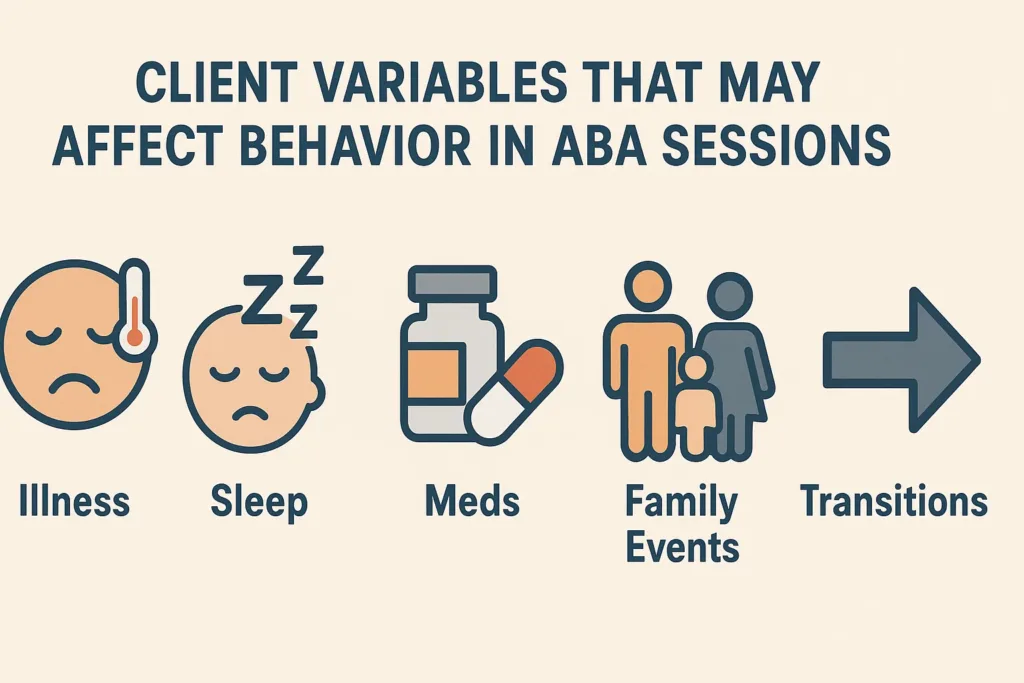
Scenario: You arrive at a session and the client seems unusually lethargic and irritable. A parent mentions the child was up most of the night coughing. Although the behavior plan is unchanged, you recognize this variable may affect data reliability and behavior patterns. It’s your responsibility to document and report this immediately.
What RBTs should do:
- Document observable signs (e.g., “Client yawned frequently and did not engage with preferred items”)
- Report subjective information as quotes from parents or caregivers (e.g., “Parent stated the child slept poorly last night”)
- Notify your supervisor and follow up as directed
Mistakes to avoid:
- Assuming the variable is “not a big deal”
- Omitting the information from session notes or verbal reports
- Treating the session as usual without alerting the BCBA
These seemingly small variables can lead to poor data interpretation or misapplied interventions if left unreported. As part of ethical reporting in ABA, RBTs must always share factors that may affect the accuracy or safety of treatment.
E-4: Generate Objective Session Notes for Service Verification
Session notes are written documentation of what occurred during a session — and they serve multiple purposes: clinical accountability, insurance verification, legal protection, and communication across the team. For RBT documentation to meet these standards, session notes must be objective, accurate, and aligned with professional expectations. Effective ABA data collection provides the measurable foundation for writing objective session notes.
Good session notes include:
- The date and time of the session
- Skills targeted and client responses
- Behavior incidents (if any), described factually
- Prompts used and client independence level
- Any relevant setting variables or session changes
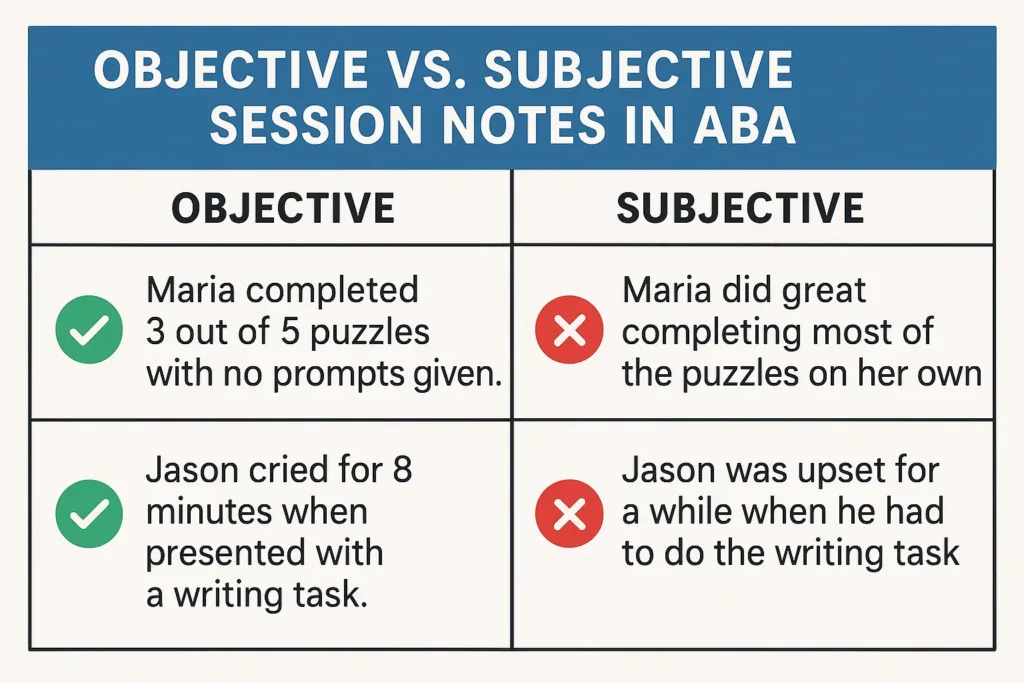
Example (objective): “Client initiated greetings with peers 4 times independently. Required full physical prompt to transition between centers. No problem behavior observed.”
Example (subjective — avoid): “Client was moody and didn’t want to cooperate today.”
RBT tips for strong session notes:
- Avoid assumptions, opinions, or emotional language
- Stick to observable, measurable behavior
- Use standard formatting and language approved by your supervisor or agency
Common mistakes:
- Writing notes in a hurry without detail
- Copy-pasting previous notes without updating specifics
- Failing to document critical events (e.g., aggression, elopement)
Accurate ABA documentation begins with sound data collection — see the Measurement module (A-1 to A-6) for how behavior data is captured.
Well-written notes help teams make treatment decisions, prove service delivery to funders, and demonstrate professionalism. For practical guidance on how to write objective, professional session notes, see this helpful resource on how to write objective ABA session notes.
E-5: Comply with Legal, Regulatory, and Workplace Documentation Requirements
In addition to recording sessions accurately, RBTs are responsible for handling documentation securely and ethically in accordance with workplace policies and legal standards, such as HIPAA. This applies to all forms of data, session notes, reports, emails, and client information. Complying with ethical and legal standards is a fundamental part of RBT documentation, especially when handling private client data. Adhering to legal and ethical reporting in ABA ensures that your documentation practices meet both workplace and regulatory standards.
Responsibilities include:
- Maintaining client confidentiality at all times
- Storing physical records in locked cabinets and digital records on secure platforms
- Not discussing client information in public or with unauthorized individuals
- Following employer protocols for data entry, updates, and access
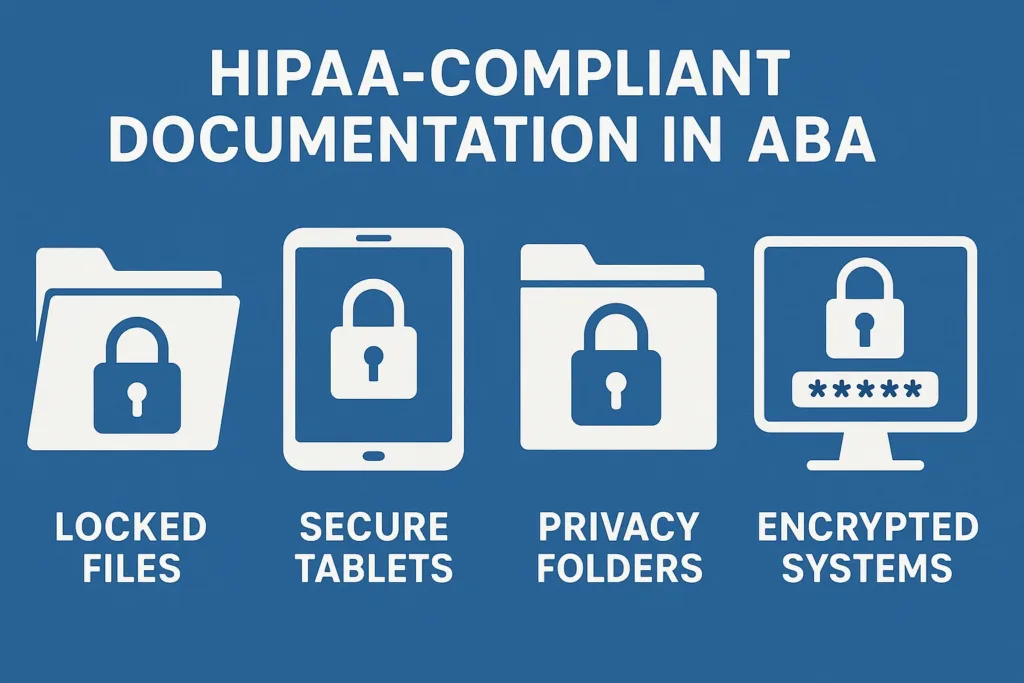
Example: An RBT leaves a session data sheet in their unlocked car. This is a serious breach of data security and could result in disciplinary action or legal consequences. Proper protocol would require placing physical data in a locked container and uploading to a secure system as soon as possible.
Tips for compliance:
- Learn your organization’s data handling policies thoroughly
- Report any accidental data breach to your supervisor immediately
- Avoid using personal phones or email for any client-related communication unless formally approved
Mistakes to avoid:
- Taking pictures of client work or sessions without written consent
- Sharing session anecdotes casually with friends or online
- Saving data to unsecured devices or drives
Complying with these standards protects your clients’ rights and your professional reputation. Legal documentation and workplace standards go hand-in-hand with ethics — covered in our Professional Conduct module (F-1 to F-5).
Conclusion: Why Documentation and Reporting Are the Backbone of Ethical ABA Practice
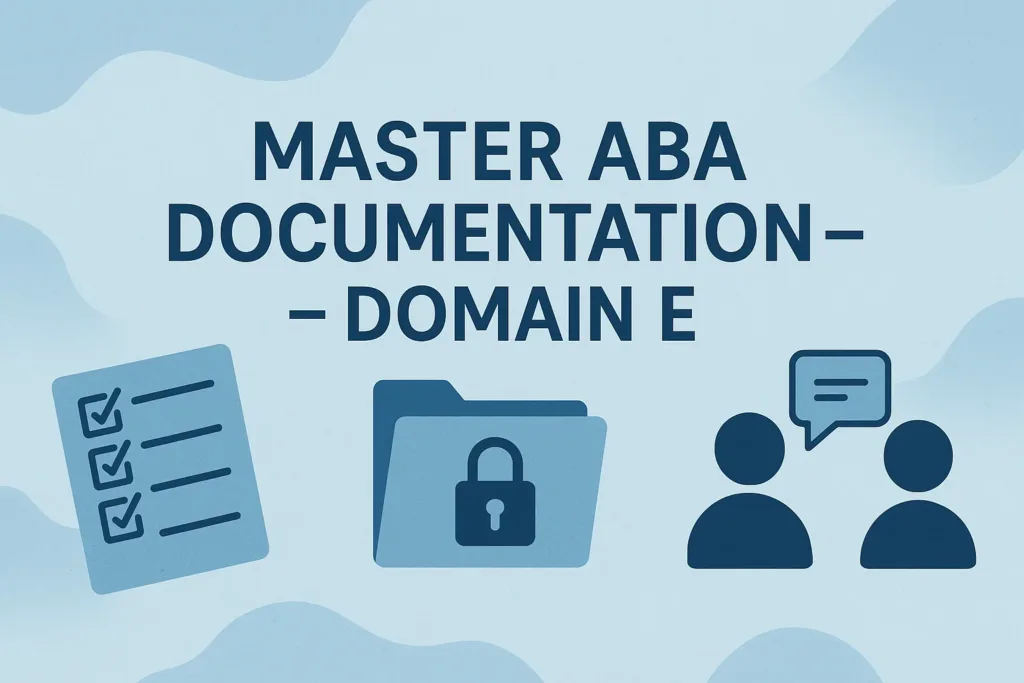
Domain E of the RBT Task List (E-1 to E-5) may seem procedural, but it is absolutely central to every effective ABA program. Accurate RBT documentation, objective session notes, and proactive communication ensure that each client’s services are ethical, safe, and grounded in data. These tasks also ensure legal compliance and protect both the client and the RBT in the event of audits, reviews, or incidents. Mastering RBT documentation practices ensures legal compliance, data accuracy, and professional accountability. Strong RBT session notes support collaboration between RBTs and supervisors, helping ensure that client goals are met consistently. Following the rules of legal and ethical reporting in ABA protects both the client and the RBT in case of audits, complaints, or reviews.
As a Registered Behavior Technician, these responsibilities are not just about paperwork — they’re about accountability. They support the collaborative nature of ABA, give your supervisors the information they need to make decisions, and uphold the trust placed in you by clients, families, and employers.
Explore all six RBT Task List domains by returning to our main RBT Study Guide.
Want to test your understanding of session notes, client variables, and compliance? Try the Documentation & Reporting Practice Test (E-1 to E-5) to reinforce your skills.
